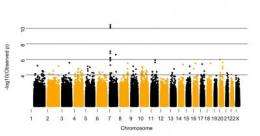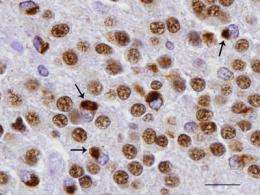New risk factor for second-most-common form of early-onset dementia

Examining brain tissue from over 500 individuals in 11 countries, researchers from the University of Pennsylvania School of Medicine and the Children's Hospital of Philadelphia, and colleagues found a new risk factor for the second-most-common cause of early-onset dementia after Alzheimer's disease.
"Using a genome-wide scan for genetic variation in post-mortem brain tissue, we were able to pinpoint variations common to patients with a specific subtype of frontotemporal lobar degeneration, FTLD," says co-first author Vivianna Van Deerlin, MD, PhD, associate professor of Pathology and Laboratory Medicine at Penn. "This gives us more information on what proteins may underlie the molecular events leading to FTLD, and eventually, new drug targets." The findings were published online this week in Nature Genetics.
"By identifying gene variants that may play a role in the development and progression of one type of FTLD, this research, if replicated, will take us one step closer to an understanding of the complex biologic pathways involved in this devastating disease," said Marcelle Morrison-Bogorad, PhD, director of the National Institutes of Health Division of Neuroscience.
The findings build on a 2006 discovery by co-senior authors Virginia Lee, PhD, director of the Center for Neurodegenerative Disease Research, and John Q. Trojanowski, MD, PhD, director of the Institute of Aging at Penn. They led an international team that found that a protein called TDP-43 accumulates abnormally in brain tissue from individuals with one type of heritable FTLD. TDP-43 is a known protein widely expressed throughout the body, with multiple functions, including regulating transcription of the genetic code and as scaffolding for nuclear and motor neuron proteins.

FTLD cases that are characterized by TDP-43 inclusions can be passed from one generation to the next, as a result of mutations in another protein called progranulin (GRN). Using post-mortem brain tissue from 515 patients with TDP-associated FTLD, the team found that these patients had multiple genetic variations called SNPs in common in a region on chromosome 7 containing the protein TMEM106B, compared to over 2,500 disease-free controls.
From this, the team concluded that the TMEM106B gene variants confer a higher genetic risk for all FTLD-TDP patients, as well as in the subset of patients with GRN mutations. What's more, alterations in levels of TMEM106B protein in the brain may be directly or indirectly involved in causing FTLD.
How TDP-43, GRN, and TMEM106B proteins might normally interact in brain cells and be disrupted in FTLD remains to be deciphered. Nevertheless, the discovery of TMEM106B is an important step toward a better understanding of FTLD. The team plans to sequence the TMEM106B segment of chromosome 7, and in parallel, study the normal functions of TMEM106B.














